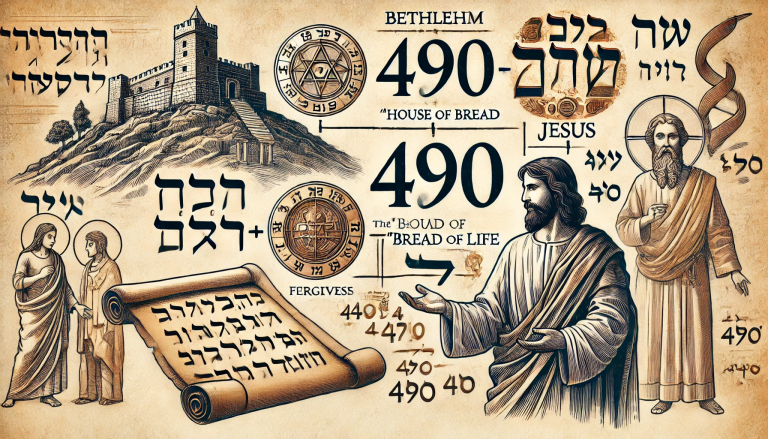
By Larry Billinger
In a world full of numbers, some stand out with profound meaning, especially in the Bible. The number 490 could be one such number, carrying deep significance and connections that span from the birthplace of Jesus to the essence of forgiveness and prophecy. I came across this idea on the internet a while back and have wanted to write an article about it. Now is my chance. I don’t know if any of it holds significance, but I find it very interesting, at the very least. I do believe that certain numbers do hold a certain significance in the Bible but let me know what your thoughts are on this one.
Other Significant Biblical Numbers
While exploring the significance of 490, it’s worth noting that the Bible is filled with numbers that carry deep symbolic meanings:
- Seven: Often regarded as the number of completion or perfection, as seen in the seven days of creation (Genesis 1).
- Forty: Frequently associated with periods of testing or trial, such as the 40 days and nights of rain during the Flood (Genesis 7:12) and Jesus’ 40 days of fasting in the wilderness (Matthew 4:2).
- Twelve: Symbolizing divine authority and governmental foundation, evident in the 12 tribes of Israel and the 12 apostles.
- Three: Representing divine wholeness or the Trinity (Father, Son, and Holy Spirit), such as Jesus’ resurrection on the third day (1 Corinthians 15:4).
The Hebrew alphanumeric list
The Hebrew alphabet consists of 22 letters, each with a corresponding numerical value. Here is the gematria (alphanumeric value) for each letter in the Hebrew alphabet:
- Aleph (א): 1
- Bet (ב): 2
- Gimel (ג): 3
- Dalet (ד): 4
- He (ה): 5
- Vav (ו): 6
- Zayin (ז): 7
- Chet (ח): 8
- Tet (ט): 9
- Yod (י): 10
- Kaf (כ): 20
- Lamed (ל): 30
- Mem (מ): 40
- Nun (נ): 50
- Samekh (ס): 60
- Ayin (ע): 70
- Pe (פ): 80
- Tsade (צ): 90
- Qof (ק): 100
- Resh (ר): 200
- Shin (ש): 300
- Tav (ת): 400
Additionally, there are five final forms of letters used when they appear at the end of a word. These final forms have different numerical values in some traditions:
- Final Kaf (ך): 500
- Final Mem (ם): 600
- Final Nun (ן): 700
- Final Pe (ף): 800
- Final Tsade (ץ): 900
These values are used in the system of gematria to derive numerical significance from Hebrew words and phrases, uncovering deeper meanings and connections within the biblical texts.
Bethlehem – The House of Bread
It’s no coincidence that Jesus, the Bread of Life, was born in Bethlehem, a town whose name literally means “House of Bread.” In Hebrew, Bethlehem is spelled בית לחם (Beit Lechem). In the Hebrew language, each letter corresponds to a numerical value, a system known as gematria. By adding up these values, we can uncover hidden meanings and connections within the text.
Let’s break down the numerical value of Bethlehem:
- Bet (ב): 2
- Yod (י): 10
- Tav (ת): 400
- Lamed (ל): 30
- Chet (ח): 8
- Mem (ם): 40
Adding these values together: 2 + 10 + 400 + 30 + 8 + 40 = 490.
Bethlehem in Hebrew, Beit Lechem, literally has a numerical value of 490. And 490 is connected to forgiveness. Think about it for a moment. Peter comes to Jesus and says, “How many times do I have to forgive? Up to seven?” He thought he was really spiritual, using the number of completion. And Jesus, unimpressed, replies, “No, seventy times seven, 490.” Any number He could have chosen, why did He choose 490? Because 490 is the numerical value of the Hebrew word תמים (tamim), which means to be perfect or complete. You can’t be perfect or complete in your faith unless you’re willing to forgive. “Let your heart be perfect” in Hebrew literally adds up to 490.
This profound connection is more than a linguistic curiosity; it’s a symbolic anchor tying Jesus’ role as the spiritual bread to His very birthplace. The numerical value of Bethlehem aligns with the concept of divine completeness and sustenance.
The Bread of Life
Bread has always been a staple in human diets, but in the Bible, it carries an even deeper meaning. Jesus, in His teachings, often used bread to symbolize essential spiritual sustenance. In John 6:35, He declared, “I am the bread of life. Whoever comes to me will never go hungry, and whoever believes in me will never be thirsty.” This powerful statement linked physical nourishment with spiritual fulfillment, emphasizing Jesus as the source of eternal sustenance.
Old Testament Prophecy
The significance of 490 extends back to the Old Testament, where it appears in the prophecies given to Daniel. In Daniel 9:24-27, the angel Gabriel speaks of “seventy ‘sevens’” (often interpreted as seventy weeks of years, or 490 years) decreed for the people of Israel and Jerusalem. This period was set to end transgression, end sin, atone for wickedness, bring in everlasting righteousness, seal up vision and prophecy, and anoint the Most Holy Place. This prophecy is closely tied to the coming of the Messiah and the ultimate redemption of Israel, further embedding the number 490 in the fabric of divine plans.
Forgiveness in the New Testament
Fast forward to the New Testament, and we see the number 490 making another significant appearance in Jesus’ teachings on forgiveness. In Matthew 18:21-22, Peter asks Jesus how many times he should forgive his brother or sister who sins against him, suggesting seven times. Jesus replies, “I tell you, not seven times, but seventy-seven times” (or “seventy times seven” in some translations, which equals 490). This response emphasizes the boundless nature of forgiveness, encouraging a spirit of limitless mercy and grace among believers.
Perfection and Completeness
Another layer of meaning is found in the Hebrew word תמים (tamim), which means “perfect” or “complete.” Its gematria value is also 490. This adds a beautiful dimension to our understanding, as Jesus is often described in the New Testament as perfect and complete, embodying the full and flawless nature of God’s plan for humanity.
Let’s break down the numerical value of tamim:
- Tav (ת): 400
- Mem (מ): 40
- Yod (י): 10
- Mem (ם): 40
Adding these values together: 400 + 40 + 10 + 40 = 490.
Conclusion
In summary, the number 490 isn’t just a random figure in the Bible; it’s a divine thread weaving through various aspects of God’s plan, from Jesus’ role as the Bread of Life born in the House of Bread to the profound teachings on forgiveness and the fulfillment of ancient prophecies. This numerical symbolism underscores the completeness and perfection of Jesus’ mission and message, offering believers a deeper appreciation of the intricate tapestry of biblical truths.



